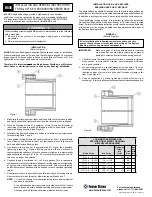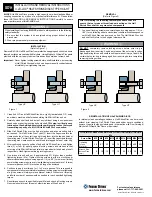
www.fennerdrives.com
For technical assistance,
please call +1-717-665-2421
B-LOC
® Keyless Bushings provide a high capacity, zero-backlash shaft/hub or
coupling connection by means of a mechanical interference fit. Please follow
these INSTALLATION AND REMOVAL INSTRUCTIONS carefully to ensure
proper performance of this
B-LOC
® unit.
WARNING
When installing or removing
B-LOC
®
products, always adhere to the following
safety standards:
1. Be sure that the system is de-energized using proper lockout/tagout
procedures.
2. Wear proper personal protective equipment.
INSTALLATION
(Refer to Figure 1)
B-LOC
® Keyless Bushings are supplied lightly oiled and ready for installation.
When reinstalling a used unit, make sure that all slits are aligned and that front
and rear clamp collars are not reversed. The frictional torque capacity of these
devices is based on a coefficient of friction of 0.12 for lightly oiled screw, taper,
shaft and bore contact areas.
Therefore, it is important not to use Molybdenum Disulfide (e.g., Molykote,
Never-Seeze or similar lubricants) in any Keyless Bushing installation.
1. Make sure that locking screw, taper, shaft and bore contact areas are clean
and lightly oiled and that all collar slits are aligned.
2. Loosen all locking screws by a minimum of four (4) turns and transfer at least
three (3) screws to equally spaced push-off threads in clamp collar Item 1
to disengage this part from center collar Item 3. To disengage collar Item
2 from taper interface, lightly tap heads of three (3) equally spaced locking
screws that have been engaged at least four (4) turns into collar Item 2 (see
Figure 1).
3. Completed assembly can now
be placed on shaft and inserted
into hub bore by pushing against
face of collar Item 1 and heads of
locking screws threaded into collar
item 2. This ensures collar Item 2
is not engaged at tapers during
this phase.
4. After placement of Keyless
Bushing, relocate locking screws
used for separation of collars.
5. Hand tighten connection and
confirm that clamp collar Item 1
is parallel with face of part to be
attached to shaft and/or with the
front facing edge of center collar Item 3.
6. Use torque wrench and set it approximately 5% higher than specified tightening
torque (Ma). Tighten screws in either a clockwise or counterclockwise
sequence (it is not necessary to tighten in a diametrically opposite pattern),
using only 1/4 (i.e., 90°) turns for several passes until 1/4 turns can no longer
be achieved.
7. Continue to apply overtorque for 1 to 2 more passes. This is required to
compensate for a system-related relaxation of locking screws since tightening
of a given screw will always relax adjacent screws. Without overtorquing,
an infinite number of passes would be needed to reach specified tightening
torque.
8. Reset torque wrench to specified torque (Ma) and check all locking screws.
No screw should turn at this point, otherwise repeat Steps 7 and 8.
NOTES:
1. It is not necessary to re-check tightening torque after equipment has
been in operation.
2. In installations subjected to extreme corrosion, the slits in clamp
collars Item 1 and Item 2, as well as in center collars, should be sealed
with a suitable caulking compound or equivalent. Likewise, push-off
threads should also be protected from corrosion.
INSTALLATION OF B-LOC® KEYLESS BUSHING
OVER SHAFT KEYWAYS
The Keyless Bushing should be positioned so that slits in Keyless Bushing
collars that contact the shaft are located approximately opposite the keyway.
In addition, a locking screw should be centered directly over the keyway.
When tightening locking screws, it is important to follow the installation
procedure outlined above, which specifies equal 1/4 turns of each locking
screw. Failure to follow these instructions could result in excessive tightening
of the screw over the keyway, possibly causing permanent deformation of
the Locking Assembly collars.
REMOVAL
(Refer to Figures 2 and 3)
Prior to initiating the following removal procedure, check to
ensure that no torque or thrust loads are acting on the Keyless
Bushing, shaft or any mounted components.
IMPORTANT!
Make sure ends of locking screws used for removal
are ground flat and are slightly chamfered to eliminate
damage to screw and collar threads during push-off.
1. Check to ensure that axial movement of clamp collars — necessary for
release of connection — is not restricted. Likewise, ensure that push-off
threads are in
good condition.
2. R e m o v e a l l
locking screws.
T r a n s f e r
r e q u i r e d
n u m b e r o f
s c r e w s i n t o
a l l p u s h - o ff
t h r e a d s o f
clamp collar
Item 1 (see
Figure 2).
3. Release collar
Item 1 by progressively tightening all push-off screws. Typically, the
push-off screws appear to be completely tight after just one pass of
tightening without any noticeable separation of clamp collars. Although
it seems that the screws cannot be tightened further, several more
rounds of torquing in either a clockwise or counterclockwise sequence
will increase the push-off force in the system and ultimately release part
of the front collar. Afterwards, only the screws which are still tight should
be tightened further until complete dismounting is achieved. Remove
collar Item 1 and cover
plate Item 4 (cover plate
Item 4 is supplied with
multiple smaller threads
at the collar face for this
purpose).
4. Transfer locking screws
used for dismounting of
collar Item 1 into all push-
off threads in center collar
Item 3 (see Figure 3).
Release collar Item 2
by repeating procedures
outlined in Step 3.
©2012 Fenner Drives B-PR-015 9/17/2012
INSTALLATION AND REMOVAL INSTRUCTIONS
FOR B-LOC
®
KEYLESS BUSHING SERIES B113
B113
LOCKING SCREW SIZES AND
SPECIFIED TIGHTENING TORQUE M
a
B113 KEYLESS BUSHINGS
Metric Series
Tightening
Torque
Ma
(ft lb)
Screw Size
Din 912
Grade 12.9
Hex
Key
Size
(mm)
180 X 285 to 220 X 325
675
M22 x 180
17
240 X 355 to 300 X 425
870
M24 x 180
19
320 X 455 to 560 X 695
1300
M27 x 220
19


































